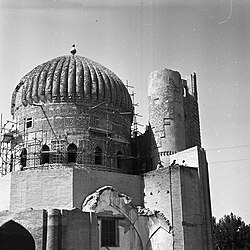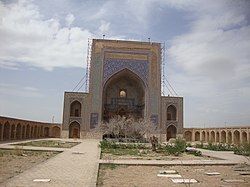Antiquities of Samarkand. Mausoleum of Emir Timur Kuragan. View of the Northwest Facade of the Mausoleum
Autor/Urheber:
Bogaevskii, Nikolai V., 1843-1912
Größe:
1024 x 1276 Pixel (1927527 Bytes)
Beschreibung:
This magnificent photograph of the Gur-Emir mausoleum in Samarkand (Uzbekistan) is from the archeological part of Turkestan Album. The six-volume photographic survey was produced in 1871-72 under the patronage of General Konstantin P. von Kaufman, the first governor-general (1867-82) of Turkestan, as the Russian Empire’s Central Asian territories were called. The album devotes special attention to Samarkand’s Islamic architectural heritage, including Gur-Emir (Persian for "tomb of the ruler"). Although known primarily as the burial place of Timur (Tamerlane), Gur-Emir was begun by Timur in 1403 to commemorate the death of his beloved grandson, Muhammad Sultan. With Timur’s own burial there in 1405, Gur-Emir became in effect the mausoleum of the Timurids. This northwest view (the original photographic title, calling this an east view, is incorrect) of the mausoleum includes a corner of the north iwan (vaulted hall, walled on three sides, with one end open) arch (far left). Despite major damage over the centuries in this active seismic zone, the central part of the ensemble remains, including the drum and great ribbed dome with ceramic tile cladding. The drum has monumental inscriptions in elongated Perso-Arabic script, while the minaret shows block Kufic script forming words from the Islamic proclamation of faith. Fragments of polychrome ceramic ornamentation are visible throughout the structure. To the right is a side view of the enormous main arch on the west side of the mausoleum.
Domes; Islamic architecture; Photographic surveys; Sepulchral monuments; Timur, 1336-1405; Tombs
Weitere Informationen zur Lizenz des Bildes finden Sie hier. Letzte Aktualisierung: Sat, 21 Oct 2023 00:50:30 GMT
Relevante Bilder
Relevante Artikel
Schrein von Khwaja Abu Nasr Parsa
Der Schrein von Khwaja Abu Nasr Parsa, heute Khwaja-Parsa-Moschee, ist ein Mausoleum und eine Moschee in der nordafghanischen Stadt Balch. Das Mausoleum wurde wenige Jahre nach dem Tod des Sufi-Gelehrten Khwaja Abu Nasr Parsa in timuridischer Zeit in der historischen Region Chorasan gegründet. Dieses durch Patronage des Generals Mīr Sayyid Mazid Bahadur Arghun zuerst entstandene Mausoleum befand sich vermutlich Mitte des 16. Jahrhunderts in einem schlechten baulichen Zustand. Der erhaltene Kuppelbau über einer oktogonalen Basis mit einem monumentalen Iwan-Portalvorbau (pischtak) und zwei Minarettstümpfen wurde schriftlichen Quellen und stilistischen Merkmalen zufolge Ende des 16. Jahrhunderts unter der Herrschaft der Scheibaniden, einer usbekischen Dynastie, erbaut. Dem entspricht die 1597/98 datierte älteste Bauinschrift des Scheibanidenfürsten und Stifters ʿAbd al-Muʾmin, der das Mausoleum mutmaßlich als Grabstätte für sich und seine Familie plante. Vom Ende des 16. bis zum Ende des 17. Jahrhunderts entstanden um das Mausoleum sechs Madrasas, die das Stadtviertel zu einem Zentrum für religiöse Bildung machten. Ein Erdbeben Ende des 19. Jahrhunderts könnte für den teilweisen Einsturz der Kuppel und der beiden Minarette verantwortlich gewesen sein. Das Gebäude wurde 1975–76 und nach 2002 restauriert und liegt heute als Kulturdenkmal und Moschee im zentralen Park der Stadt.
.. weiterlesen






